View in other NatureServe Network Field Guides
NatureServe
Montana
Utah
Wyoming
Idaho
Wisconsin
British Columbia
South Carolina
Yukon
California
New York
Heart-leaved Buttercup - Ranunculus cardiophyllus
State Rank Reason (see State Rank above)
Rare in Montana, where it is primarily distributed in the north-central part of the state.
- Details on Status Ranking and Review
Population Size
Score2 - Small: Generally 2,000-10,000 individuals.
Range Extent
Score1 - Peripheral, Disjunct or Sporadic Distribution in MT: Widespread species that is peripheral, disjunct or sporadically distributed within MT such that it occurs in <5% of the state (<7,500 sq. miles or the combined area of Beaverhead and Ravalli Counties) or is restricted to 4-5 sub-basins.
Area of Occupancy
Score2 - Low: Generally occurring in 4-10 Subwatersheds (6th Code HUC’s).
Environmental Specificity
Score1 - Moderate: Species is restricted to a specific habitat that is more widely distributed or to several restricted habitats and is typically dependent upon relatively unaltered, good-quality habitat (C Values of 5-7).
Trends
ScoreNA - Rank factor not assessed.
Threats
Score1-2 - Medium to High.
Intrinsic Vulnerability
Score0-1 - Low to Moderate Vulnerability.
Raw Conservation Status Score
Score
7 to 9 total points scored out of a possible 16 (Rarity factors and threats only).
General Description
Heart-leaved Buttercup is a fibrous-rooted perennial with erect, branched stems that are 15-40 cm high. The basal leaves have spade-shaped blades that are 2-6 cm long and toothed margins and petioles that are 2-12 cm long. The few, alternate stem leaves are deeply divided like fingers on a hand. The foliage is covered with straight, spreading hairs. Stalked flowers arise from the axils of the uppermost leaves, or bracts, forming an open, few-flowered inflorescence. Each saucer-shaped flower has 5 yellowish sepals that fall off shortly after opening, 5 yellow petals that are 8-15 mm long, each with a small basal pocket with long hairs at the top, and numerous stamens and ovaries. The cylindric fruiting heads bear 20-100 flattened, egg-shaped, hairy achenes that are 1-2 mm long; each has a short, straight beak on top.
Phenology
Flowering end of May-June, fruiting in July.
Diagnostic Characteristics
There are many species of buttercups. A technical key and hand lens or microscope are required for positive determination. The combination of spade-shaped basal leaf blades, long, cylindrical fruit heads up to 12 mm high, and hairy achenes with straight beaks help to identify this species. It resembles Ranunculus pinnatifidus, which has dissected basal leaves, and R. verecundus, which has smaller petals.
Species Range
Montana Range
Range Descriptions
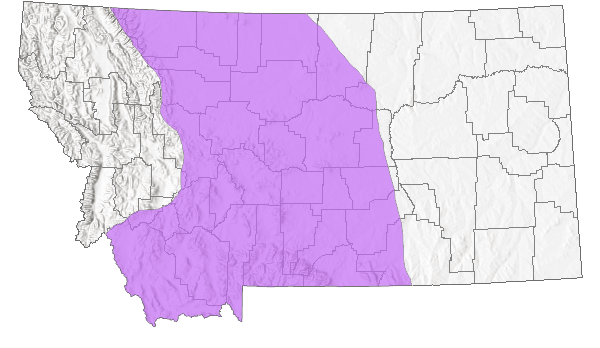
 Native
Native
Range Comments
BC to SK south to WA, NM and SD (Lesica et al. 2012. Manual of Montana Vascular Plants. BRIT Press. Fort Worth, TX).
Observations in Montana Natural Heritage Program Database
Number of Observations: 14
(Click on the following maps and charts to see full sized version)
Map Help and Descriptions
Relative Density
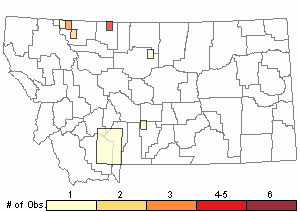
Recency
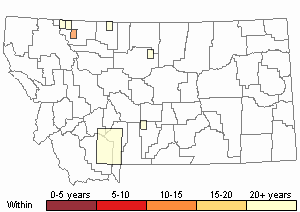
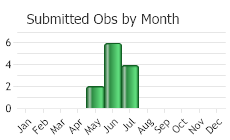
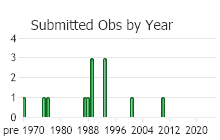
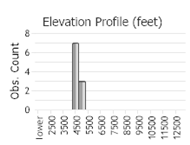 (Observations spanning multiple months or years are excluded from time charts)
(Observations spanning multiple months or years are excluded from time charts)
Habitat
Moist meadows and grasslands often associated with wetlands in the foothill zone.
National Vegetation Classification System Groups Associated with this Species
Forest and Woodland
Deciduous Forest and Woodland
Grassland
Lowland - Prairie Grassland
Wetland and Riparian
Wet Meadow and Marsh
Ecology
POLLINATORS The following animal species have been reported as pollinators of this plant species or its genus where their geographic ranges overlap:
Bombus auricomus,
Bombus bifarius,
Bombus nevadensis, and
Bombus bimaculatus (Macior 1968, Thorp et al. 1983).
Stewardship Responsibility
Threats or Limiting Factors
STATE THREAT SCORE REASON
Reported threats to Montana's populations of Heart-leaved Buttercup are those from noxious species. Leafy Spurge (Euphorbia virgata) occurs in the vicinity of at least one population (MTNHP Threat Assessment 2021).
References
- Literature Cited AboveLegend:
 View Online Publication
View Online Publication Lesica, P., M.T. Lavin, and P.F. Stickney. 2012. Manual of Montana Vascular Plants. Fort Worth, TX: BRIT Press. viii + 771 p.
Lesica, P., M.T. Lavin, and P.F. Stickney. 2012. Manual of Montana Vascular Plants. Fort Worth, TX: BRIT Press. viii + 771 p. Macior, L.M. 1968. Bombus (Hymenoptera, Apidae) queen foraging in relation to vernal pollination in Wisconsin. Ecology 49:20-25.
Macior, L.M. 1968. Bombus (Hymenoptera, Apidae) queen foraging in relation to vernal pollination in Wisconsin. Ecology 49:20-25. MTNHP Threat Assessment. 2021. State Threat Score Assignment and Assessment of Reported Threats from 2006 to 2021 for State-listed Vascular Plants. Botany Program, Montana Natural Heritage Program, Helena, Montana.
MTNHP Threat Assessment. 2021. State Threat Score Assignment and Assessment of Reported Threats from 2006 to 2021 for State-listed Vascular Plants. Botany Program, Montana Natural Heritage Program, Helena, Montana. Thorp, R.W., D.S. Horning, and L.L. Dunning. 1983. Bumble bees and cuckoo bumble bees of California (Hymenoptera: Apidae). Bulletin of the California Insect Survey 23:1-79.
Thorp, R.W., D.S. Horning, and L.L. Dunning. 1983. Bumble bees and cuckoo bumble bees of California (Hymenoptera: Apidae). Bulletin of the California Insect Survey 23:1-79.
- Additional ReferencesLegend:
 View Online Publication
View Online Publication
Do you know of a citation we're missing? Heidel, B.L. 1994. Sensitive plant survey in the Sweetgrass Hills, Liberty and Toole Counties, Montana. Unpublished report for the Great Falls Resource Area, Lewistown District, Bureau of Land Management. Montana Natural Heritage Program, Helena, MT.
Heidel, B.L. 1994. Sensitive plant survey in the Sweetgrass Hills, Liberty and Toole Counties, Montana. Unpublished report for the Great Falls Resource Area, Lewistown District, Bureau of Land Management. Montana Natural Heritage Program, Helena, MT. Lesica, P., M.T. Lavin, and P.F. Stickney. 2022. Manual of Montana Vascular Plants, Second Edition. Fort Worth, TX: BRIT Press. viii + 779 p.
Lesica, P., M.T. Lavin, and P.F. Stickney. 2022. Manual of Montana Vascular Plants, Second Edition. Fort Worth, TX: BRIT Press. viii + 779 p. Westech, Inc. [Western Technology and Engineering]. 1989. Rare plant inventory and plant community descriptions of the Sweet grass Hills Proposed Area of Critical Environmental Concern (PACEC), Toole and Liberty Counties, Montana. Unpublished report to USDI Bureau of Land Management, Great Falls, Montana, 36 pp. plus appendices.
Westech, Inc. [Western Technology and Engineering]. 1989. Rare plant inventory and plant community descriptions of the Sweet grass Hills Proposed Area of Critical Environmental Concern (PACEC), Toole and Liberty Counties, Montana. Unpublished report to USDI Bureau of Land Management, Great Falls, Montana, 36 pp. plus appendices.
- Web Search Engines for Articles on "Heart-leaved Buttercup"





